The Story of the Yaghan People of South America
Yaghan from Tierra del Fuego defied many conventions in human society. They wore little or no clothes, had no personal belongings and lit fires in their wooden canoes to signal others and stay warm. Needless to say, they thrived for millennia as a nomadic people and skilled naval hunters in the midst of the harsh conditions at the forefront of South America.
Centuries of colonialism would eventually precede the loss of the last thoroughbred Yaghan. Today, all that seems to be left of the culture are ceremonial bark masks, documentation of the language isolate and descendants of mixed blood who promise to preserve the Yaghan heritage. The following tells the story of the Yaghans' coming and going, as well as why their language and tradition continue to survive and should not just be written off as primitive.
The Origins of Yaghan
Scientists have struggled to identify where Yaghan, or Yámana, first came from. Many people understand that they gained access to America from Siberia 15,000 XNUMX years ago via the Bering land bridge. But recent theories suggest that certain groups may have come thousands of years earlier.
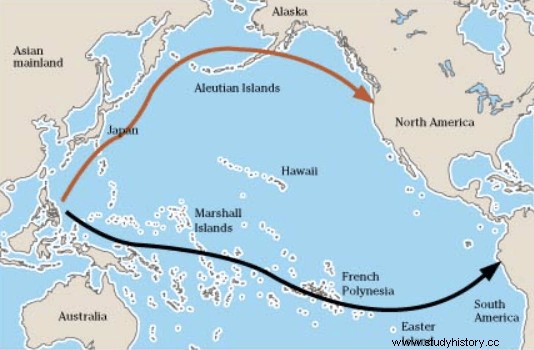
Yaghan's ancestors probably first settled around Tierra del Fuego 10,000 XNUMX years ago. They either migrated rapidly from present-day Alaska to the other end of America, leaving minimal traces, or arriving via a completely separate and geographically different route. Recently published paleontological evidence suggests that Yaghan may also have inhabited the Falkland Islands, or Falkland Islands , at a time before the arrival of British or Argentine settlers.
The Spanish biologist Carles Lalueza-Fox discovered that Yaghan and other indigenous groups in Tierra del Fuego had the genetics most similar to the Paleo-Indians, America's first inhabitants. However, Brazilian biologist Walter Neves and Argentine anthropologist Héctor Pucciarelli noticed that the groups had similar teeth and skulls as Aboriginal Australians. The cave art, body painting, and advanced vision of the Selk'nam people of Tierra del Fuego also closely resembled those of the Aborigines.
Rewriting history
This is in conflict with the traditional notion of a single migration from Australasia to America. This suggests that another, and probably earlier, migration wave occurred directly from Australasia to South America across the Pacific Ocean.
If this theory were true, the migrants may have traveled over a gradual period of time via island hopping. We need to reconsider our conventional understanding of how people first inhabited America to better understand the role, if any, Australians and Melanesians played in the population of Tierra del Fuego.
Survival of the fittest
Yaghan thrived for 7,000 years amidst the harsh climate, arctic winds and heavy rainfall in Tierra del Fuego. Unable to sustain any agriculture, these nomadic hunter-gatherers held out in the bays and coves of Argentina's tip as the world's southernmost indigenous group.
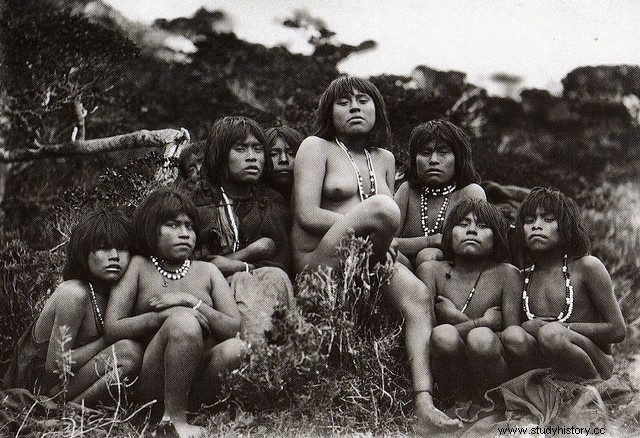
They lived mostly on a marine diet, using heavy harpoons to catch fish, birds and marine mammals and diving to collect oysters, mussels and other shellfish from along the coast. Yaghan women not only acted as sexual companions and domestic workers, they also helped to gather food underwater and acted skillfully as hunters.
"Land of Flames"
Despite wearing minimal clothing, Yaghan gradually adapted to the archipelago's cold temperatures of around -20 degrees C. The constant rain soaked otherwise what kind of outfit they were wearing. Instead, they resort to skimming greasy layers of fish or self-fat to protect themselves from the elements. They also knew how to build rock formations and huts for shelter, but they preferred to sleep in the sheltered outdoors. And as they traveled through the snow, they remained barefoot.
As a result, Yaghan may have developed a higher core body temperature and stronger metabolism than most people. The natural squatting position they assumed when stationary allowed them to conserve body heat and reduce exposure to the elements.
And their bonfires became so important in generating heat that they even lit them in their own canoes while at sea. Fire also doubled as their means of long-distance communication, leading explorers to call the region the "land of fire" ("tierra del fuego") after observing Yaghan's many man-made fires around the coast.
Fuegians
The term yamana is the Yaghan word for "man", while yagán translated as "us". But Charles Darwin used "Fuegian" as an umbrella term for any indigenous people in Tierra del Fuego. Yaghan wanted to capture the attention of Darwin in the 1830s, who noted their minimal attire:
"These Fuegians in the canoe were quite naked, and even an adult woman certainly was. It rained heavily, and the fresh water, along with the spray, trickled down her body. In another harbor not far away came a woman, who was breastfeeding a newly born child, one day next to the vessel, and remained there while sleet fell and thawed on her naked bosom and on the skin of her naked children. "
And while Yaghan made a remarkable impression on Darwin at least, he remained critical of their minimalist and natural lifestyle:
"When you look at such men, you can hardly make yourself believe that they are fellow creatures and inhabitants of the same world. At night, five or six people sleep, naked and barely protected from wind and rain in this stormy climate, on the wet ground tangled like animals. "
Myth and ceremony
Yaghan designed ceremonial masks from bark and whale intestines to represent the transformation of the human spirit into natural phenomena, fundamental to their China myth. It tells the story of women who once painted their faces to trick men into submitting to their supernatural powers. After learning that women lacked such abilities, the men slaughtered them and secured a majority of power over the Yaghan community for good. The deceased women were then reborn into the wildlife that populates the region today.
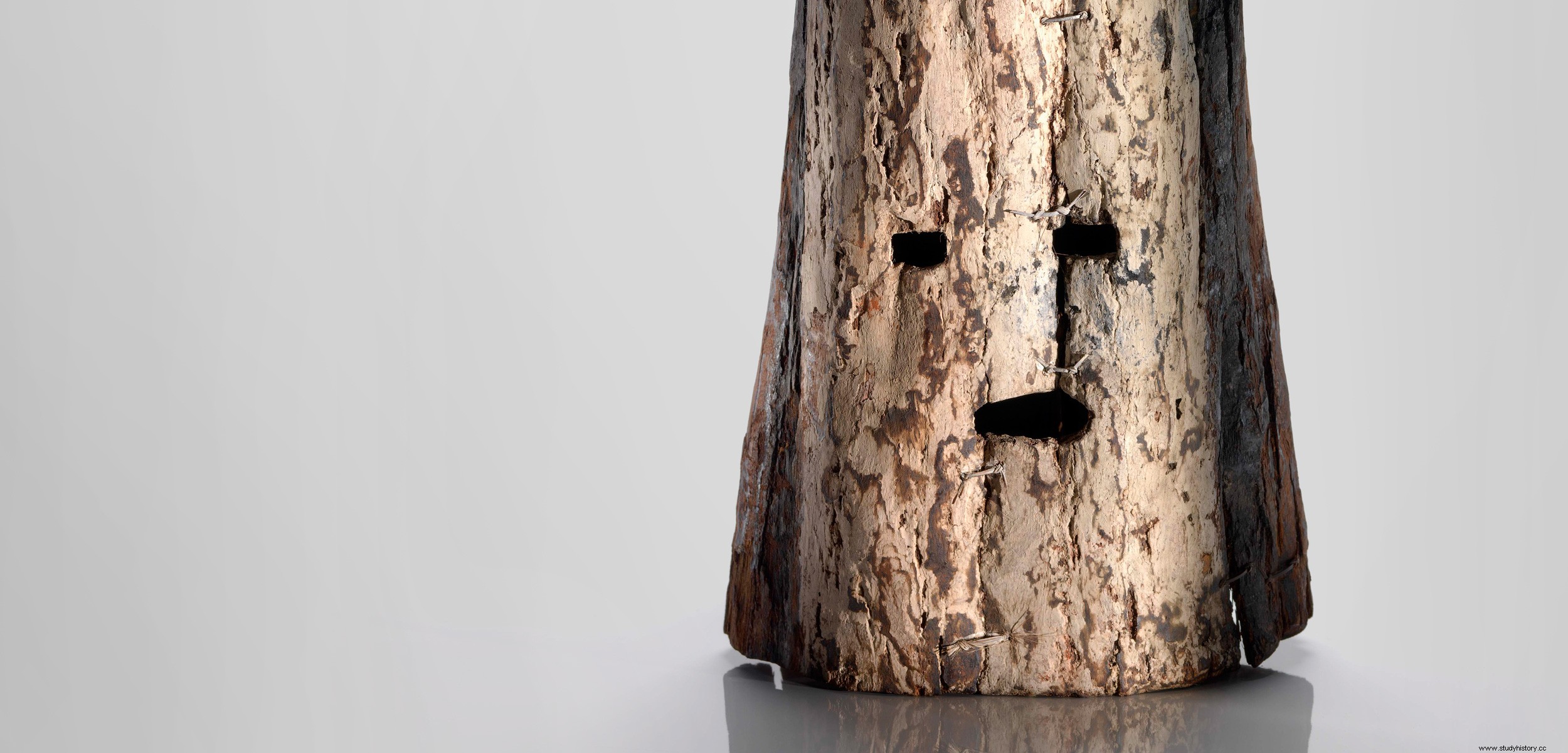
This creation myth is intended to be interpreted spiritually, rather than on a linear or rational level. Yaghan's masks came to represent mythical characters such as the moon woman Hannuxa , solmann Löm , and Rainbowman Akainix . And the associated China the ceremony lasted several days to celebrate the growing age of young Yaghan men, most recently in 1922 on Navarino Island in Chile.
The Austrian ethnologist Martin Gusinde and the German anthropologist Wilhelm Koppers attended the historic event. By then, it had not happened in almost 50 years due to the decline in the Yaghan population. Unfortunately, this last ceremony served more as a desired re-introduction than as the authentic cultural event it once was.
Interactions with other indigenous groups
In the 19th century, four large indigenous groups existed around Tierra del Fuego:around 5,000 Alacalufe, or Kawésqar; about 3,000 Ona, or Selk'nam; about 2,500 Yaghan; and about 300 Hauch, or Manek'enk. These groups had neither social structure nor personal property, and only shamans maintained a certain degree of privilege.
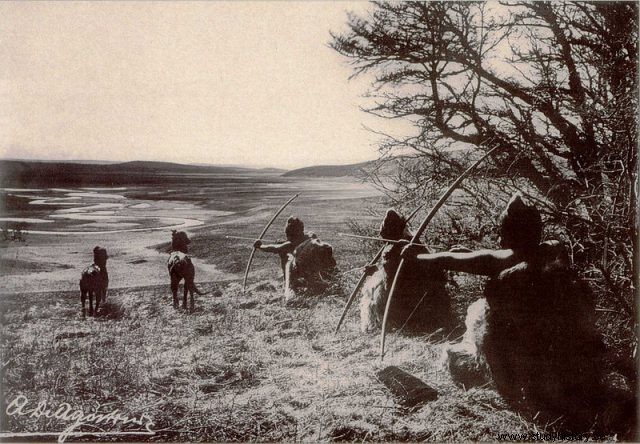
The rural Ona occupied the northern prairies and southern forests of the region, and hunted guanacos and tuco-tucos with late-stringed bow and arrow. They instilled fear in Yaghan, whom they regularly attacked to assert dominance over. And they drove Hauch, who reached the area before they did, to the coldest corner of Isla Grande de Tierra del Fuego.
They also wore heavy fur and leather shoes and wore jewelry made from shells, bird bones and guanaco tendons. They developed as a particularly tall people, with their men averaging six feet, and their hain the inauguration ceremony coincided with potlatches in the Pacific Northwest. Darwin regarded the infamous Ona as "miserable lords in this miserable land."
Colonial contact
The Portuguese explorer Ferdinand Magellan, the first European to round the southern cape, gave the first account of Tierra del Fuego in 1520. Indigenous groups such as Yaghan would then be a spectacle for all subsequent visitors, who came in search of gold, oil and plains. It was not until December 1832 that Darwin came to document his first encounter with Yaghan:
"In the afternoon we anchored in the Bay of Good Success. When we entered, we were greeted in a way that became the inhabitants of this wilderness. A group of Fuegians sat on a wild spot that hung over the sea; and as we passed by, they sprang up and sent out a loud and loud cry. It was without a doubt the most curious and interesting play I had ever seen. "
James Cook, Francis Drake and James Weddell also wanted to write some early ethnographic accounts of Yaghan. But it was permanent European settlers who would pose serious threats to Tierra del Fuego's indigenous groups.
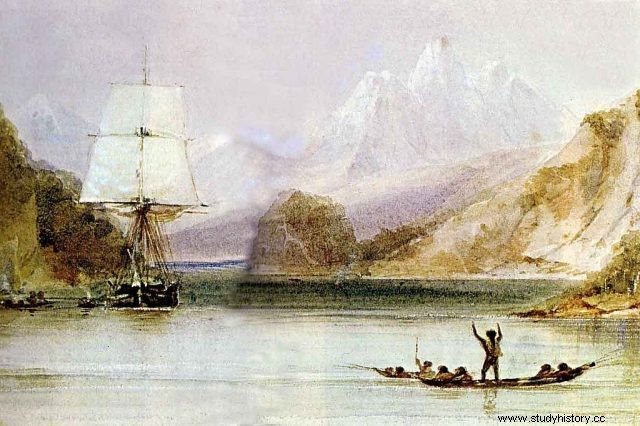
Settlers and the Fur Trade
Anglican evangelism and the civil and social pressure of missionaries in the seventeenth century cut off generations of Yaghan oral tradition. Mixing their culture with the culture of settlers and other indigenous groups further contributed to total assimilation. And forcing them to abandon their nomadic lifestyle proved all the more harmful.
After European colonization of the region in the nineteenth century, the growing Yaghan population of around 3,000 people was reduced to just 130 members in 50 years. After another half century, the group was almost completely gone. Settlers, who brought disease and over-hunted food sources, often also killed Yaghan on purpose out of fear or defiance.
Whalers and fur traders had mainly settled in the eighteenth century, and the subsequent decline in otter and sea lion populations forced Yaghan to change a diet they had enjoyed for generations. The settlers also took advantage of Yaghan's knowledge of the country, hiring them as guides and trading items of little commercial value for precious furs and skins.
Hunting or being hunted
The Chilean government began to rule the Strait of Magellan and build cities in the 1840s. Both Chile and Argentina encouraged huge immigration to the south and offered free land to sheep farmers and prospectors at the discovery of gold in the 1880s.
The Onaes, who fought in the midst of declining guanaco populations and thought the sheep were white guanacos, began hunting livestock instead. For the next 15 years, colonists issued bounties of as much as one pound sterling for every Ona killed, taking their severed body parts as evidence of extinction.
Julius Popper, a conquistador from Romania and an architect from Havana, Cuba, became rich in gold in Tierra del Fuego and led the mass hunt for Ona. His staff wanted to reduce the population to just three percent of the number of Ona in the nineteenth century.
Measles in the 1920s killed all the group's survivors, whom the colonists had either moved to nearby islands or transported to European zoos. Around 2,000 people claim Ona heritage today, but both their language and culture are still extinct. Over 2,600 people also continue to carry Alacalufe blood, but only a dozen full-blooded Alacalufe still exist.
Nowhere to hide
In the midst of increased sea traffic, many Yaghan fled to Puerto Remolinos in Argentina and Mejillones in Chile. The Chilean government had moved most of Yaghan to Villa Ukika in the 1970s due to the construction of a naval base in Mejillones. And while the country aims to make health care, policing and education more accessible to Yaghan, this would only lead to further assimilation.
The Navarino Island Yámana Community was formed in 1992 to preserve Yaghan's history and culture and alleviate the group's poverty and marginalization. The community helped revive Yaghan crafts and activities such as weaving reed baskets, building canoes, repairing small boats and catching and selling crab and other seafood. In 2002, more than 1,650 Chileans identified themselves as Yaghan
The last of Yaghan
Cristina Calderón, the last surviving thoroughbred Yaghan, passed away in February at the age of 93. She brought with her all the remaining knowledge of how to speak the Yaghan language, which was vastly different from even the other indigenous languages of Tierra del Fuego. Her father, Juan, probably made many of the masks and other Yaghan artifacts preserved today, including baskets and ceremonial wands.

Emelinda Acuña, another Yaghan speaker who died in 2012, may have been the second thoroughbred Yaghan to last travel around the world. Cristina Calderón, whose sister died in 2003, expressed in 2016 the isolation she felt as the last remaining Yaghan speaker:
"When my sister Úrsula passed away, I was left alone, without anyone to talk to. I learned Spanish when I was nine years old. The father of a niece of mine was a gringo , and they taught me little by little. At that time, everyone spoke Yaghan, but later they began to die, and I was left alone. The children did not want to learn the language. They were ashamed. White people laughed at them. "
A human treasure
Both the Chilean government and UNESCO have considered Calderón a living human treasure. However, none of her seven children and 14 grandchildren speak her mother tongue. Her youngest daughter, Lidia González, recently tweeted the following:
"I feel deep sorrow for not being with her the moment she died. This is sad news for the Yaghan people. "
Lidia González Calderón, an indigenous legislator currently helping to draft Chile's next constitution, said she hopes to preserve both her mother's heritage and language:
"All the work I do at present, I do in your name, and your people will also be reflected in that work."
"Although with her death we lose a wealth of empirical knowledge, especially valuable in linguistic terms, the possibilities for saving and systematizing the language are open."
Preserving the language
The Yaghan language includes more than 32,000 5,000 words, a respectable amount considering that most people who speak any language can use less than 1870 in standard conversations. The Anglican missionary Thomas Bridges visited Tierra del Fuego as a teenager in the 10th century and lived with the Yaghans for 30,000 years before compiling a Yaghan English dictionary of 1948 XNUMX words. Esteban Lucas, one of his sons whom he grew up speaking the Yaghan language, published an account of his experience growing up in their culture in his book from XNUMX Outer Part of the Earth .
More than 60 years later, Calderón and her granddaughter Cristina Zárraga, whose indigenous name ( Ikamakipa ) is translated as "the woman who writes," put together her own Yaghan-Spanish dictionary. It was accompanied by a CD that contained recordings of how to pronounce certain words. And a book the grandmother and granddaughter wrote, Hai Kur Mamašu Shis ("I want to tell you a story"), describes various indigenous legends, songs and stories.
The importance of preserving Yaghan culture
Despite harsh criticism from Darwin and other early visitors to Tierra del Fuego, Yaghan persisted against all odds in the midst of the region's highly unfavorable environment. Their stronger metabolism, higher body temperature and skill in marine hunting testify to both their resilience and adaptability. Furthermore, they developed languages, myths and ceremonies that became as complex and sophisticated as in any modern culture.
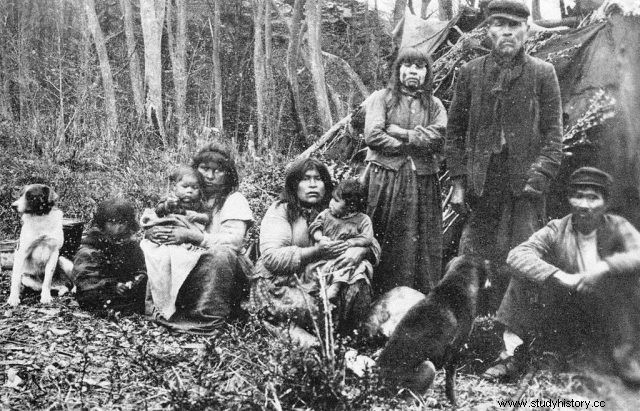
The devastating effects of colonialism have now brought a sad and final end to the true Yaghan lifestyle. But the language continues to survive, as evidenced by Bridges and Calderón, and groups such as the Navarino Island Yámana Community have made incredible efforts to preserve the craft and practice of culture.
Although there may not be more thoroughbred Yaghan left to convey their stories and traditions orally, we have now equipped ourselves with the traces they have left behind. So it is important that we actively work to maintain the Yaghan culture that settlers once ridiculed and tried to reduce. If we do not, the legacy of these people may disappear once again - and this time perhaps forever.
Referenced Materials
https://historyofyesterday.com
https://english.elpais.com
https://hakaimagazine.com
https://www.adventure-life.com
http://chileprecolombino.cl
https://fromtheparapet.wordpress.com
https://www.outdoorrevival.com
https://www.theguardian.com
